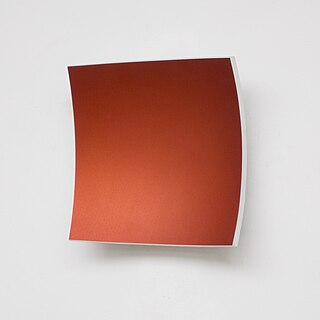
Friedrich Stowasser, better known by his pseudonym Friedensreich Regentag Dunkelbunt Hundertwasser, was an Austrian visual artist and architect who also worked in the field of environmental protection. He emigrated to the Far North of New Zealand in the 1970s, where he lived and worked for most of the rest of his life.

Günther Förg was a German painter, graphic designer, sculptor and photographer. His abstract style was influenced by American abstract painting.

Markus Vater is a German artist. He studied at the Kunstakademie Düsseldorf and the Royal College of Art, London. From 2012 to 2016 he had been teaching at the Royal College of Art in London. In 2014 he had a guestprofessorship at the Hochschule für bildende Künste Hamburg and from 2016 to 2019 at the Staatliche Akademie der Bildenden Künste Karlsruhe. Currently he is teaching at the Hochschule der bildende Künste Essen. His studio is at Studio Voltaire. Vater lives in London and works in London and Essen.

The Helsinki School was a name introduced in an article by Boris Hohmeyer, Aufbruch im hohen Norden, in art Das Kunstmagazin in 2003. This was the first time it was used as a brand name to describe a selection of artists who had studied under adjunct professor Timothy Persons at the University of Art & Design in Espoo from the beginning of 1990s. So far, with over a 180 international publications, the Helsinki School represents a collaborative approach, where students of photography, not only work together by presenting each other's works but, exhibit with their professors, mentors and former alumni in a joint effort to share in mutual contextual dialogue that uses the photographic process as a tool for thinking.
Józef Mroszczak was a Polish graphic designer.

The Master of the Saint Bartholomew Altarpiece was an Early Netherlandish painter active in Germany, mostly Cologne, between 1475/1480 and 1510. Despite his anonymity, he is one of the most recognizable artists of the early Renaissance period in German art.
Norbert Müller-Everling is a contemporary German artist working with concrete art.

Ivo Ringe is a German artist, who is classified as a concrete art painter. He is also a docent and a curator of international group exhibitions.

Diet Sayler is a German painter and sculptor.
Michael Reisch is a German artist and photographer. Reisch exhibited nationally and internationally. His works are included in collections worldwide, including the Los Angeles County Museum of Art, USA and National Gallery of Scotland Edinburgh, Scotland. His works combine aspects of documentary photography, painting and sculpture. He lives in Düsseldorf.

Kurt Wendlandt was a German painter, printmaker, photographer, author and illustrator. His work incorporates paintings, drawings, statuary, photogram, Décollage, light graphics and photos. Books illustrated by Wendlandt have been published in (Germany), the United Kingdom, the Netherlands, Austria, Sweden, Switzerland and the GDR.
Thomas Rusch is a German photographer living in Berlin, Hamburg and Paris.

Heiner Thiel is a German sculptor and curator. He is an exponent of concrete art.

Heinz Zander was a German painter, graphic artist, illustrator and writer. Zander belongs to the Leipzig School. His fields of work are painting (oil), drawing, graphics and illustration. Zander was also active as a writer and published novels, stories and essays. He worked with painting techniques oriented towards the Old Masters, from which he developed a completely independent pictorial language. Zander was inspired by Bosch, Grünewald, Altdorfer, Cranach and Italian Mannerists. He worked mainly with colourful resin-oil glazes.
Bernard Aubertin was a French artist born in 1934 in Fontenay-aux-Roses, France. He died in August 2015 in Reutlingen, Germany.
Gottfried Jäger is a German photographer, photo-theorist and former university teacher.

Sandra Mann is a German artist and photographer. In her cross-genre work, she deals conceptually with the relationship between people, with nature, the environment, the animal world and gender issues. Her work is characterized by research into the fundamentals of photography and visual language. In 2021, she was awarded the Goethe plaque from the city of Frankfurt am Main.
Bodo Baumgarten was a German painter, sculptor, graphic artist, and educator. He is a former professor at Hochschule der Bildenden Künste Saar (HBK) in Saarland.
Timothy Persons is a US-American curator, writer, artist, and adjunct professor based in Berlin and Helsinki.
Clemens Pasch was a German sculptor and painter.










